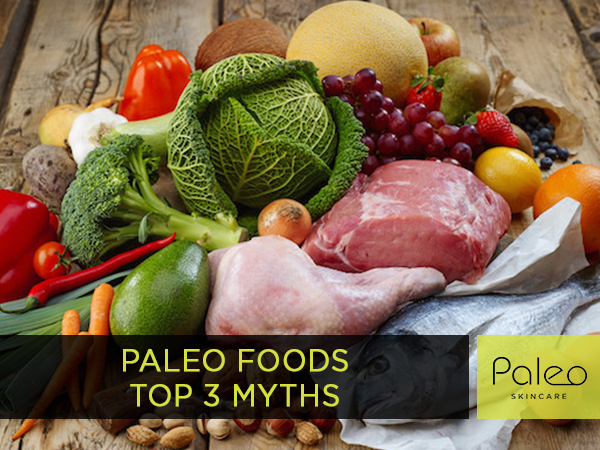Paleo Foods: Top 3 Myths
Author: Paleo Skincare

Here is a short rundown on how to compose a perfectly Paleo meal. The Paleo diet is so very popular due to its high success in providing health and vitality so it is easy to google a comprehensive list of which foods are generally considered acceptable and which foods are entirely advised against by Paleo purists.
How do I know what foods are considered “Paleo”?
The Paleo diet is so very popular due to its high success in providing health and vitality so it is easy to google a comprehensive list of which foods are generally considered acceptable and which foods are entirely advised against by Paleo purists.
However, for convenience’s sake, here is a short rundown on how to compose a perfectly Paleo meal.
First, there are a few common dietary misconceptions you’ll have to let go of:
Myth 1: All fat is bad
This simply isn’t true. The Paleo diet encourages the consumption of healthy fats like animal fat, ghee, avocados, macadamias, almonds, cashews, and other nuts. Some fat in the diet is necessary for a healthy metabolism and body.
Myth 2: Cutting out entire food groups is far too drastic to be healthy
This can be considered glaringly false when you consider the fact that grains and dairy only entered the human diet relatively recently — at the advent of agriculture roughly 10,000 years ago. (Note: 10,000 years only sounds like a long time until you consider the full span of human existence.) It is because of their recent introduction to our diets that our guts haven’t got what it takes to digest these foods for optimal health.
Myth 3: Milk is an absolute necessity in the adult diet
Despite the fact that it is so often touted as the key to getting healthy bones and teeth, dairy does not seem to ever have been intended to be a long-term ingredient in the human diet. If the widespread and rapidly increasing prevalence of lactose intolerance doesn’t convince you of that fact, then maybe a reminder that we seem to be just about the only mammals that continue consuming milk past infanthood will.
Food for thought:
When humans are very young, they drink milk from their mothers in order to get the nutrients their bodies need to survive. The same is true for cows and many other mammals. Cows have four stomachs to digest the milk that they drink from their mothers, but humans only have one. Obviously, human babies are not cows, and their gastrointestinal tracts do not function in the same manner that cows’ gastrointestinal tracts do. This is why it is not recommended to offer children under the age of one year old cows’ milk-it is too difficult for them to digest! The fact that we are not cows and do not function precisely as cows do does not change as we grow older. Why, then, do we continue to drink cows’ milk as adults, even though we no longer need to drink milk of any kind in order to get the nutrients our bodies need to survive?
If you’re following the Paleo template in your meal planning every meal or snack you consume will provide you with all of the building blocks necessary for a health body (carbohydrates, fat, protein, vitamins, and minerals).
Paleos plan each meal starting with the protein.
Unless you are enjoying a vegetarian meal, you should be eating a portion of some animal product about the size of your palm or even a little bigger with each meal. You needn’t worry about going hungry while on this diet, as Paleo meals include loads of vegetables. Occasionally, these may be substituted or supplemented with fresh fruits, as well. As fats will serve as your main source of energy, you’ll need to add some healthy fat to each and every meal. The precise amount will depend on what protein source you choose for each meal. A dinner that includes leaner meat can easily be rounded out with the addition of an avocado or a nice handful of nuts. Finally, add a glass of water and you’re good to go!
